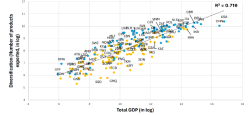Mining is a large global industry. Annual output across 66 countries is worth around an estimated US $1.6 trillion. Yet local communities located around mine sites and host countries often see limited benefits. This is why governments adopt “local content” policies to enhance economic opportunities for local people and the country at large. In this blog post, which draws on IGF’s Guidance for Governments on Local Content Policies, we discuss the importance of local content policies along the mineral value chain, including for mining suppliers, mineral processors and manufacturers.
What is local content?
There is no universal definition of local content. It varies from country to country. Local content policies have a crucial role to play along the mineral value chain, including for mining suppliers, mineral processors and manufacturers. They are designed to translate investment in mining into greater benefits for host countries, aiming to strengthen economic opportunities linked to mining for local companies and workers. This can be achieved through:
- Upstream linkages: opportunities created by local procurement by mining companies
- Horizontal linkages: economic opportunities created in any industry through using capabilities, infrastructure or skills developed to serve mining companies
- Downstream linkages: opportunities to process minerals and/or use them to produce goods and services. These are often referred to as “value addition”.
- Local ownership and employment: opportunities for local companies to act as mining operators, often through state-owned companies, and for local people to work for mining companies
Fiscal revenues from mining are not typically considered to be part of local content. Although currently a great deal attention is being paid to forward linkages / “value addition”, other types of local content can also present important opportunities.
Why does local content matter?
Local content matters because it is a key way to ensure that host countries benefit from their mining industries by spurring industrial development, alongside fiscal revenues from mining. For example, promotion of opportunities for local companies to supply Malaysia’s oil industry helped that country’s economy to transform rapidly and become industrialized. China’s development of the copper industry created close to 1 million jobs and supported industrial development further down the value chain. As well as being important in and of itself, local content is also important for developing mining companies’ ‘social licence to operate’ in local communities.
Though some have identified a trade-off between promotion of local content and fiscal revenues in mining, which one matters more may depend on the country in question, how large the development opportunities from local content are and how they compare to the potential benefits of fiscal revenues in a specific case. In addition, countries dominated by natural resource extraction–particularly low- and middle-income countries–can experience slower economic growth depending on the quality of governance (Figure 1), and greater exposure to economic shocks, inter alia.
Figure 1: Association between diversification and GDP, 2020

Source: Freire, 2025.
Under the right circumstances, local content can contribute to addressing these problems. Developing non-mining industries at different stages in the value chain–industries that do not suffer the same problems of resource industries and develop capabilities that lead to faster and more sustainable and inclusive economic growth–can be an effective solution.
Figure 2: Key success factors for local content policies

Source: Authors, based on IGF (2018)
Other key success factors are outlined Rodrik and Stiglitz (2025).
Risks of local content policies
Although local content policies benefit host countries, they can have negative effects where they are pursued too aggressively. Consider the ongoing race to ‘win’ the global energy transition, with many countries trying to domesticate industries along critical mineral value chains. Where this denies mining countries the economic benefits that can come with local content by shifting most of the mineral value chain elsewhere, this could worsen public frustration in low- and middle-income mineral producers. For example, governments and civil society in many countries are dissatisfied with the fact that they export minerals after little to no processing. In response, some countries are restricting exports of raw materials, to require mining companies to process locally.
Public frustration with missing out on more lucrative economic activities in mineral value chains increases the risk of mineral supply disruptions, which can mean that even countries that domesticate midstream and downstream mineral-based industries will lose out if they cannot source the minerals to supply them. Competition over local content policies could also lead to a costly economic ‘arms race’ that could hinder global growth. Policies aimed at boosting productivity and developing competitive industries over time may therefore be preferable.
In conclusion, local content policies provide a key opportunity to increase the economic benefits from mining for host countries and local communities.
To seize these opportunities, governments need to get the details right – through aligning with national priorities; taking stock of opportunities, challenges and capabilities; prioritising opportunities and designing appropriate policies; and monitoring, enforcing and adjusting policy as necessary.
However, the ongoing aggressive competition to localise mineral-based industries also comes with risks. Achieving the right balance and fairly sharing the benefits and costs along mineral value chains is therefore essential.
The IGF provides Guidance for Governments on Local Content Policies alongside additional resources and technical assistance on request to support governments in formulating local content policies.
This work is based on a forthcoming report supported by the Deutsche Gesellschaft für Internationale Zusammenarbeit.

